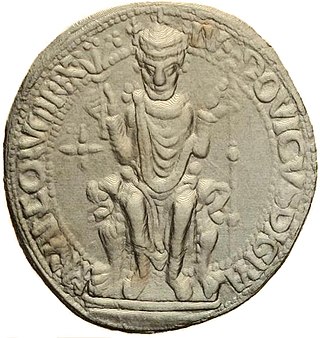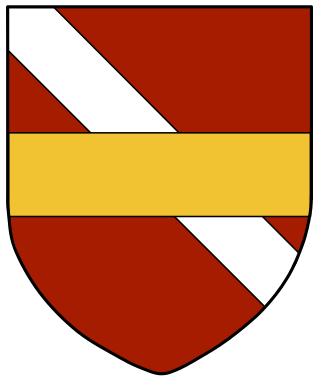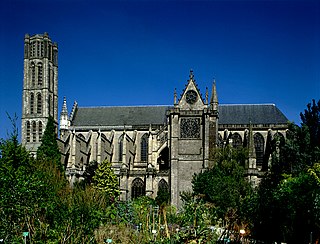
Feudalism, also known as the feudal system, was a combination of legal, economic, military, cultural, and political customs that flourished in medieval Europe from the 9th to 15th centuries. Broadly defined, it was a way of structuring society around relationships derived from the holding of land in exchange for service or labour.

Charles the Bald, also known as Charles II, was a 9th-century king of West Francia (843–877), King of Italy (875–877) and emperor of the Carolingian Empire (875–877). After a series of civil wars during the reign of his father, Louis the Pious, Charles succeeded, by the Treaty of Verdun (843), in acquiring the western third of the empire. He was a grandson of Charlemagne and the youngest son of Louis the Pious by his second wife, Judith.

Hugh Capet was the King of the Franks from 987 to 996. He is the founder of and first king from the House of Capet. The son of the powerful duke Hugh the Great and his wife Hedwige of Saxony, he was elected as the successor of the last Carolingian king, Louis V. Hugh was descended from Charlemagne's son Pepin of Italy through his paternal grandmother, and was also a nephew of Otto the Great.

Louis VI, called the Fat or the Fighter, was King of the Franks from 1108 to 1137. Like his father Philip I, Louis made a lasting contribution to centralizing the institutions of royal power. He spent much of his twenty-nine-year reign fighting either the "robber barons" who plagued the Ile de France or Henry I of England for his continental possession of Normandy. Nonetheless, Louis VI managed to reinforce his power considerably, often resorting to force to bring lawless knights to justice, and was the first member of the house of Capet to issue ordonnances applying to the whole of the kingdom of France.

William FitzOsbern, 1st Earl of Hereford, Lord of Breteuil, was a relative and close counsellor of William the Conqueror and one of the great magnates of early Norman England. FitzOsbern was created Earl of Hereford in 1067, one of the first peerage titles in the English peerage. He is one of the very few proven companions of William the Conqueror known to have fought at the Battle of Hastings in 1066. His chief residence was Carisbrooke Castle on the Isle of Wight, one of many castles he built in England.
A fabliau is a comic, often anonymous tale written by jongleurs in northeast France between c. 1150 and 1400. They are generally characterized by sexual and scatological obscenity, and by a set of contrary attitudes—contrary to the church and to the nobility. Several of them were reworked by Giovanni Boccaccio for the Decameron and by Geoffrey Chaucer for his Canterbury Tales. Some 150 French fabliaux are extant, the number depending on how narrowly fabliau is defined. According to R. Howard Bloch, fabliaux are the first expression of literary realism in Europe.

John of Montfort, sometimes known as John IV of Brittany, and 6th Earl of Richmond from 1341 to his death. He was the son of Arthur II, Duke of Brittany and his second wife, Yolande de Dreux. He contested the inheritance of the Duchy of Brittany by his niece, Joan of Penthièvre, which led to the War of the Breton Succession, which in turn evolved into being part of the Hundred Years' War between England and France. John's patron in his quest was King Edward III of England. He died in 1345, 19 years before the end of the war, and the victory of his son John IV over Joan of Penthièvre and her husband, Charles of Blois.
Waiofar, also spelled Waifar, Waifer or Waiffre, was the last independent Duke of Aquitaine from 745 to 768. He peacefully succeeded his father, Hunald I, after the latter entered a monastery. He also inherited the conflict with the rising Carolingian family and its leader, Pepin the Short, who was king of the Franks after 751 and thus Waiofar's nominal suzerain.
The title Duke(and Prince)of the Franks (Latin: dux(et princeps)Francorum) has been used for three different offices, always with "duke" implying military command and "prince" implying something approaching sovereign or regalian rights. The term "Franks" may refer to an ethnic group or to the inhabitants of a territory called Francia.

The Diocese of Tulle is a Latin Church diocese of the Catholic Church in Tulle, France. The diocese of Tulle comprises the whole département of Corrèze.

The Diocese of Limoges is a Latin Church diocese of the Catholic Church in France. The diocese comprises the départments of Haute-Vienne and Creuse. After the Concordat of 1801, the See of Limoges lost twenty-four parishes from the district of Nontron which were annexed to the Diocese of Périgueux, and forty-four from the district of Confolens, transferred to the Diocese of Angoulême; but until 1822 it included the entire ancient Diocese of Tulle, when the latter was reorganized.

The Metropolitan Archdiocese of Montpellier (–Lodève–Béziers–Agde–Saint-Pons-de-Thomières) is a Latin archdiocese of the Catholic Church in south-western France. The current metropolitan archbishop is Pierre-Marie Carré; the immediate past Archbishop Emeritus is Guy Marie Alexandre Thomazeau. On September 16, 2002, as part of the reshuffling of the map of the French ecclesiastical provinces, the diocese of Montpellier ceased to be a suffragan of Avignon and was elevated to archdiocese and metropolitan of a new ecclesiastical province, with the dioceses of Carcassonne, Mende, Nimes and Perpignan–Elne as suffragans.

Rodulf was the archbishop of Bourges from 840 until his death. He is remembered as a skillful diplomat and a proponent of ecclesiastical reform. As a saint, his feast has been celebrated on 21 June.
Frothar or Frotar was an Aquitanian prelate in West Francia, who held two different bishoprics and three abbacies during a long career. He was appointed Archbishop of Bordeaux around 859, but Viking raids forced him to abandon his seat in 870. With papal approval, he was transferred to the Archdiocese of Bourges in 876. He died after 893.

Beaulieu-sur-Dordogne is a commune in the Corrèze department in the Nouvelle-Aquitaine region, central France. Beaulieu is a medieval city, originally dominated by its great abbey of St Pierre, of which only the abbey church remains. On 1 January 2019, the former commune Brivezac was merged into Beaulieu-sur-Dordogne. It is a member of Les Plus Beaux Villages de France Association.
Rodulf Haraldsson, sometimes Rudolf, from Old Norse Hróðulfr, was a Viking leader who raided the British Isles, West Francia, Frisia, and Lotharingia in the 860s and 870s. He was a son of Harald the Younger and thus a nephew of Rorik of Dorestad, and a relative of both Harald Klak and Godfrid Haraldsson, but he was "the black sheep of the family". He was baptised, but under what circumstances is unknown. His career is obscure, but similar accounts are found in the three major series of Reichsannalen from the period: the Annales Bertiniani from West Francia, the Annales Fuldenses from East Francia, and the Annales Xantenses from Middle Francia. He died in an unsuccessful attempt to impose a danegeld on the locals of the Ostergo.

Bodashtart was a Phoenician ruler, who reigned as King of Sidon, the grandson of King Eshmunazar I, and a vassal of the Achaemenid Empire. He succeeded his cousin Eshmunazar II to the throne of Sidon, and scholars believe that he was succeeded by his son and proclaimed heir Yatonmilk.
Wenilo was the archbishop of Sens from 836 or 837. Prior to becoming bishop, Wenilo was a palatine chaplain. As bishop, he was one of the leading men in Aquitaine and crowned Charles the Bald king in 848, definitively uniting Aquitaine with West Francia. In 858, he supported the East Frankish invasion and was denounced as a traitor by the king. They reconciled the next year, and Wenilo retained his office until his death. Nevertheless, he passed into legend as Ganelon, the archvillain of the Matter of France, his name a byword for "traitor".
Simon de Beaulieu was a French bishop and Roman Catholic Cardinal. He was the son of Guy, Sieur de Beaulieu and of Agnes. Simon's brother, Jean, was Abbot of the Cistercian monastery of Notre Dame-de-Jouy in the diocese of Sens. Simon had another brother, Raoul, who was also buried (1286) at Jouy along with their mother.

Solignac Abbey, or the Abbey of Saint-Peter and Saint Paul of Solignac, is an abbey in Solignac, near Limoges, in Haute-Vienne. It was founded around 631 AD by Saint Eligius (Éloi). The present buildings date to the 12th century, but have been modified many times since then. The abbey was dissolved during the French Revolution and the buildings were put to new uses, including a prison, boarding school, porcelain factory and seminary. As of 2021 there were plans to restore it back to its original function as a monastery.